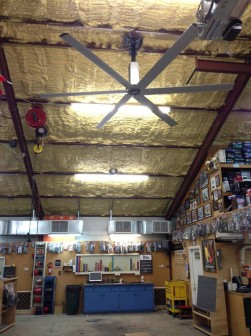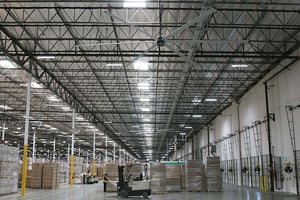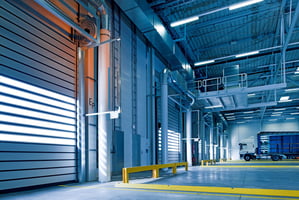Warehouses and logistics facilities generally encompass massive square footage. They are filled...
5 Quick Tricks to Keep a Warehouse Heated in the Winter

Facility Managers are often looking for solutions to help keep their warehouse employees comfortable in the winter months. These facilities, typically with large square footage, rarely have heating for cold winter months. So, employees are often left to cope with the less than desirable temperatures. The cold months can leave the warehouse workers operating at lower productivity and complaining about the chill. Subject matter expert, Jonathan Jover, the International Sales Representative for MacroAir fans is very familiar with the heating issues faced by Warehouse and Logistics Managers. Jover discusses 5 quick tricks to keep a warehouse heated in the winter and master the problem of employee discomfort.
1. Check the Doors
Warehouse doors open and close all day. Employees work in bulky protective clothing on slippery floors. If the operations of your facility don’t permit you to keep the doors closed, you can check their fit, speed, and maintenance. As industry expert Jonathan Jover notes,
"As doors open and close constantly, it represents a huge loss of heat, energy, and expense in the cold climates."
A solution to this problem is High Volume, Low Speed (HVLS) fans. These HVLS fans can act as a barrier between outside and inside air. Working with radiant heat, HVLS fans can move a column of air upwards from the fan, mixing the warmer air at the ceiling with the cooler air near the floor and de-stratifying the space; leaving a more comfortable temperature throughout. Jover’s testament to HVLS fan success comes from his direct experience with successful warehouse and logistic facility installations. Jover explains;
"Even if you have your bays open, HVLS fans do not let as much heat escape. In many cases I’ll go into a facility after their HVLS fans are installed and see workers in short-sleeves when it is freezing cold outside, and they still aren’t get any heat loss and the business is saving on their heating costs…"
2. Check the Floor Plan
A wet warehouse floor is often a revealing sign of evaporation problems which is commonly presented as Sweaty Slab Syndrome. You can train employees on how to respond to the risk of slips and falls, but wet spots can indicate a problem with the air.
Air layers stratify horizontally and vertically. This results from the air's natural physics, where warmer air rises above cooler air. Without circulation, air will naturally stratify.
If you want to protect people, products, and productivity, it is imperative to manage the environment by de-stratifying the air. Strategically placed, HVLS fans will move such a volume of air that it will reconfigure the air, evaporating moisture on the floor and ultimately reducing employee safety issues.
3. Check the Ceiling
While the temperatures at the floor may be cold, oftentimes there is warm air up at the ceiling. Warm air naturally rises and, combined with warmth from the sun on the roof and lighting that gives off heat, this is where the hot air is usually located in your warehouse. Through the use of HVLS fans, warehouses can re-distribute the warm air and push it down to satisfy climate needs at ground level.
When HVLS fans are integrated with an existing HVAC system, it can ease the strain on the system, saving you money on electric bills and increasing the lifespan of your HVAC unit. Jonathan Jover speaks of installing fans to manage the temperatures in facilities over 30,000-square feet and with ceilings exceeding heights of 30-feet.
“With temperature sensors at ceiling and floor, HVLS fans can respond automatically to the slightest temperature variation. Effectively acting as a built-in "brain", the fans can sync with other systems to vary the speed and/or direction [of the air] to correct the variance.”
4. Check the Design
Many warehouses have no heating at all. Retrofitting them with HVAC systems is often cost-prohibitive. But, even without HVAC, any large space has its own aerodynamics that can be utilized to change the temperature at floor level.
With no ductwork involved, HVLS fans rotate quietly to direct heat where it is needed, rectify areas of poor circulation, and redistribute the temperature. Jover explains,
"Because the sun radiates its heat on the ceiling of the warehouse, there's always a higher temperature up there than at floor level. So, we've used these automated systems to be able to de-stratify the air with a change in temperature as much as 3 to 5° F."
5. Check the Price
When finding a solution to provide warmth in your warehouse, there are several financial components to consider:
- Upfront price of the solution
- Price that it will cost to run the solution
- Anticipated service costs for the solution
- ROI of the solution
HVLS fans not only manage temperatures year-round, but their price sets them apart from other solutions. In addition to operating for pennies a day, HVLS fans leverage your existing solutions and often lower their operating costs. HVAC systems will not run as frequently or as hard because of the HVLS fans. With a good industrial fan, you get an extensive service warranty. What's more, you get an extended life and service interval from your existing HVAC system.
There is also a return on investment when your employees work more comfortably, your equipment works more efficiently, and your energy costs go down. Instead of pricing energy spent, you can price energy saved.
Conclusion
These five responses are more than just quick fixes. Each remedy is an element of a larger picture. Comfort and cost savings need not be mutually exclusive. Smart choices, strategic planning, and HVLS fans can resolve most of your problems.
Jonathan Jover is an expert with HVLS fan technology and has worked in the industry since 2008. He has a global understanding of HVLS fan solutions acting as the International Sales Representative for MacroAir fans in key regions throughout the world.

